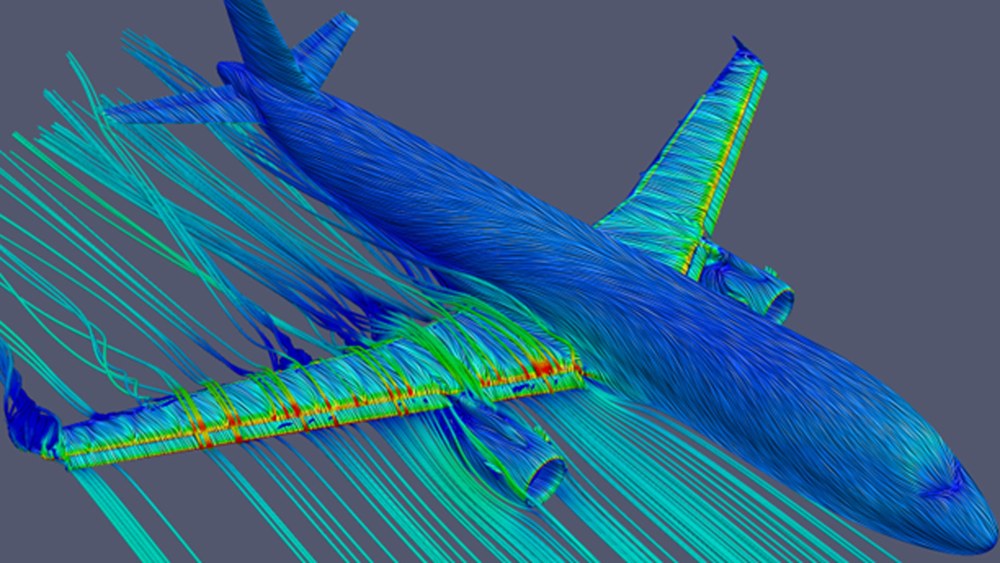Accelerating climate-compatible flying with AI


The path to climate-compatible flying involves energy-efficient aircraft, low-emission engines and optimised flight paths. Digitalisation can accelerate these developments, for example by simulating the airflow around an aircraft – requiring high-performance computers to process vast quantities of data. The German Aerospace Center (Deutsches Zentrum für Luft- und Raumfahrt; DLR) has now demonstrated how machine learning and artificial intelligence (AI) can provide critical support both in the generation and processing of this data.
"With our software, we can very accurately simulate the airflow for various situations encountered in flight operations and analyse it accordingly," explains Stefan Görtz from the DLR Institute of Aerodynamics and Flow Technology in Braunschweig. "Numerous flow conditions and aircraft configurations are relevant in the design and certification process. However, calculating each of these using conventional fluid mechanics is prohibitively costly. This is where deep artificial neural networks become invaluable, as they can process large quantities of unstructured data. We have specifically adapted these machine learning methods for use in aerodynamics, enabling us to make many rapid predictions." Remarkably, these predictions are nearly as accurate as those generated by traditional methods, allowing researchers to reliably forecast complex flow phenomena, such as compression shocks and separation zones.
More accurate simulations mean better aircraft evaluation
Shock waves, for instance, arise when aircraft fly slower than the speed of sound but the airflow around their wings reaches supersonic speeds in specific areas. In these cases, the flow state changes abruptly, resulting in shock waves that increase air resistance, and in certain situations, airflow can no longer follow the wing surface – separating from it. "Accurately simulating such flow phenomena is essential to reliably assess the aerodynamic properties and, consequently, the efficiency of future aircraft and engines," says Stefan Görtz.
The research team also employs AI techniques to improve turbulence models. Turbulent flows are characterised by irregular fluctuations in velocity and pressure. By combining DLR's simulation and measurement data, researchers have refined existing models using AI. These advancements enable better predictions and understanding of chaotic, swirling air movements. "What's new here is that reliable conclusions can be drawn even without exhaustively calculating every detail of the simulation," adds Görtz.
Numerical simulation: how does air flow around the wings?
In the recently completed SMARTfly (Smart Modelling of Flying Transport Vehicles) project, the team, led by Philipp Bekemeyer and Stefan Görtz, further enhanced the numerical flow simulation – computational fluid dynamics, CFD – which has been in use for decades. The CFD calculations are conducted on DLR's two supercomputers, CARA and CARO, in Dresden and Göttingen. The numerical simulation applies a virtual grid around the object, with the computers calculating the flow equations for each individual cell within the grid. The smaller the cell, the more precise the results – and the greater the computational effort. The CFD software, CODA, jointly developed by ONERA, DLR and Airbus, was designed to optimise the use of current and future computer hardware. "With CODA, we can now simulate flow behaviour at various speeds, from hovering helicopters to passenger aircraft in cruising flight. To achieve both within a single software package is a unique capability."
This software is not only suitable for aviation applications but also in simulations for wind turbines, cars, trains, ships and even spacecraft, as well as for the sloshing of fuel in hydrogen tanks.
In the long term, SMARTfly's results will aid in advancing the virtual certification of new aircraft types. Researchers can assess the impact of design changes on fuel consumption and predict the in-flight behaviour of particular configurations early in the development process.
Related links
- DLRmagazine 173 – High-speed nodes – DLR's CARA and CARO supercomputers support research projects with their exceptional computing power
- Aerodynamics and the art of aircraft design
- Featured topic – Climate-compatible aviation
- Featured topic – Artificial intelligence
- DLR site Braunschweig, Dresden and Göttingen
The SMARTfly project
The SMARTfly project is part of the DIGIfly (Digital Flight of Air Vehicles) joint project, funded by the German Federal Ministry for Economic Affairs and Climate Action (BMWK). Alongside the DLR Institute of Aerodynamics and Flow Technology, industrial companies and universities, the DLR Institute of Propulsion Technology and the DLR Institute of Software Methods for Product Virtualization were also involved.
SMARTfly's focus is on the further development of the CFD-flow solver CODA and the DLR software libraries for data-driven modelling and optimisation, AutoOpti (engines) and SMARTy (aircraft).
Aviation research at DLR
DLR's aeronautics research considers aircraft and air transport as an integrated system, paving the way for a climate-compatible future with reduced CO2 and non-CO2 effects. To this end, DLR is developing highly integrated technological solutions, methods and processes. Digitalisation serves as a catalyst, accelerating the shift towards climate-compatible aviation.
